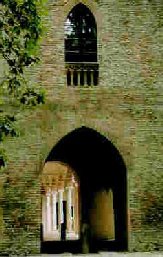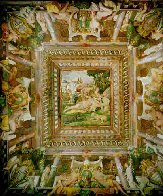
The castle’s construction began with Bertrando Rossi around 1385. The fortress is situated in a position of strategical and commercial importance on the line of the Francigena road which connects Milan with Parma, which then continues towards Rome via Bologna and Florence: just to the east runs the Taro river, which is about to join into the righthand side of the Po river, which is navigable as far as the estuary.

From Troilo I (feudatory since 1502 till 1521) and his successors Pier Maria III (1521-1547) and Troilo II (1547-1591), the Rossi of San Secondo become tightly related to the most important italian families - Riario, Sforza, Medici, Gonzaga, Rangone - and the ancient fortress is tranformed into an elegant Renaissance castle. The court of San Secondo during the 16th century is open to the collaboration and the patronage of illustrious artists and literary men, from Pietro Bembo to Francesco Mazzola 'the Parmigianino', from Benvenuto Cellini to the great Pietro Aretino 'Scourge of Princes'
All the rooms were embellished with considerable magnificence. The Room of
the Gold Dunky (nearly 1530) is very suggestive, with the original and
unique frescoe’s representation of the homonymous roman of Apuleio,
seventeen pictures for a strip cartoon "ante litteram". The Room of the
Caesars is coeval, the small office of the count Pier Maria III, of evident
Mantuan School (Giulio Romano’s disciples).
In the Gallery of Aesop and the Rooms with fables the iconography reflects
the political moments lived by the family, with the cruel references to the
contrasts during the fourties with the established power (the Pope Paolo
III, Alessandro Farnese).
The Representation’s Rooms are inspired to classical mythology, allegory of
the regret for the lost positions but also pitiless self-criticism to get
into Farnese’s, new dukes of Parma, good books (Orazio Sammacchini and other
artists of the Bolognese School).
The great and magnificent Room of the "Gesta Rossiane", with its imposant
pictorial ornament (nearly 1200 metres square of frescoes) celebrates, by
allusions to a general peace, the great story and feats of the noble
family since 1199 till 1542 (Cesare Baglione, Jacopo Bertoja, Giovan Antonio
Paganino, Ercole Procaccini).